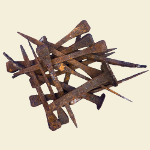Artifact: Figured India Muslin Kerchief

Materials: Cotton
Dimensions: 35 ½ x 34 ¾ in; 90.17 x 88.265 cm
Date: 1775
Origin: India
Collection: Smithsonian
License: Fair Use
Ledger Entry: Handkerchief

Department: Accessories
Customer: John Gist
Ledger Page: 35
Imported From: Handkerchiefs were frequently imported to the colonies from India, England, France, and Scotland. There were three handkerchiefs in the Ramsay databases identified as Sastracundy, identifying the particular region of their manufacture in India.
Product Description
Handkerchiefs are square pieces of fabric, typically cotton, linen, or silk. They were used by both men and women for a variety of uses. Functionally they were used to sop up tears or sweat and to blow ones nose. As accessories they were also used for display, either worn around the shoulders or neck, or brandished, dropped, or exchanged as part of flirting and courtship rituals. Their ornamentation could be printed, embroidered, or trimmed with lace.
Citation: Raymond B. Clark Jr. “Historical Handkerchiefs” New York History 36:2 (1955): 189-196.; Linda Baumgarten. Eighteenth-Century Clothing at Williamsburg. (Williamsburg, Va: Colonial Williamsburg Foundation, 1986), 42, 71.
Historical Price: 12pence; Modern USD: $11.2
Product Variations
The databases record fifty-three handkerchiefs in an assortment of materials including cotton, linen, silk and lawn. Vorlinda Wade purchased a pair of handkerchiefs identified as India handkerchiefs. The prices range from nine shillings for a cotton romall handkerchief, to four shillings for a fine lawn handkerchief.






